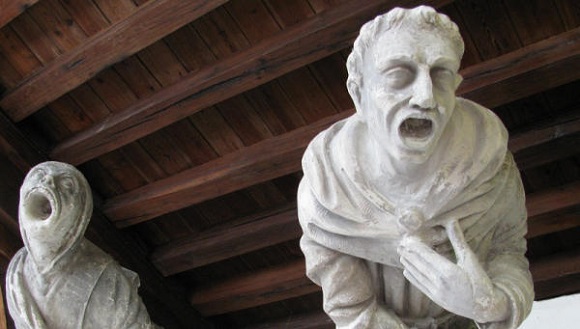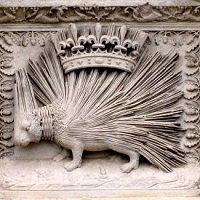
To Blois or not to Blois, that is the question that travelers ask when planning their itinerary of Loire Valley chateaux. Though not as photogenic as some the other stars of the valley, Blois, easily accessible from Paris, is in many ways the key to understanding royal history and architecture all along the Loire. This illustrated article examines the men and women who made Blois, followed by information about hotels, B&Bs and restaurants in Blois and in the surrounding area.
* * *
Blois (pronounced a sharp blwa, vampire-like) holds a prominent place on the map, yet its castle is often ignored in favor of more photogenic stars of the valley. Chambord, Chenonceau, Villandry, Azay-le-Rideau, Usée and Saumur, for example, readily lend themselves to adjectives such as majestic, exquisite, idyllic, dramatic, elegant or storybook. (Match the adjectives with the chateaux and you get a free subscription to France Revisited for the rest of this year.)
Blois Castle, le château de Blois, stands on a rise on the right bank of the Loire but it offers no great photo op from the river. The Blois Tourist Office might well sue me for libel for showing this gray-weather shot from the bridge across the river.
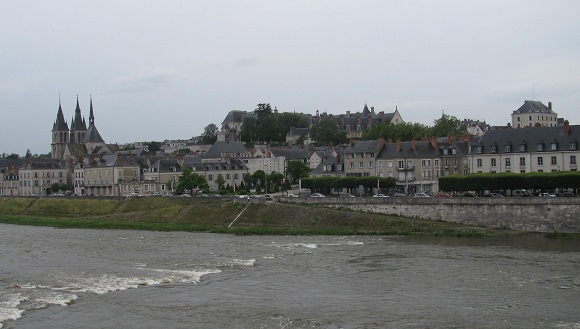
And the main entrance to the castle is more promising though still not as imposing or impressive or fairy-tale as we’d like our castles to look, particularly when seen under an indeterminate sky.
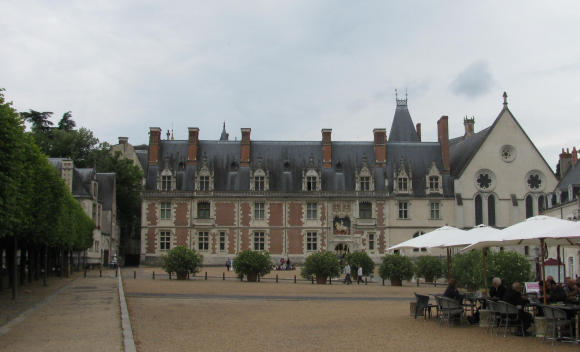
But that doesn’t make Blois any less notable. This is in fact the most historically and architecturally significant of the chateaux of the Loire Valley. Admittedly, that isn’t a line you use to get your spouse to choose Blois as a vacation destination or to get your 12-year-old excited about a trip abroad (how about telling him/her that there’s a Magic Museum with dragons in the windows across the square?). Nevertheless, Blois is a key to understanding the valley’s castle-scape.
What it lacks in outward photogenia it makes up for in details, in revealing history and in convenience to daytripper and valley bikers. Blois does have character(s). You just need to get closer to see it/them.
Let’s take a look.
Amboise Castle, a left bank chateau 22 miles downstream, is more photogenic from across the river but it’s now far less notable inside. Amboise is where Charles VIII (born 1470-reigned 1493-died 1498) died from fracturing his skull on a door lintel (careful when visiting old castles, folks, they weren’t designed with Disney building standards in mind, and just you try suing someone for tripping on a cobblestone).
Charles VIII and Queen Anne of Brittany were childless, so with no direct heir his cousin Louis d’Orléans ascended to the throne as Louis XII (1462-1498-1515).
Louis XII
Louis may have had Orleans in his name but he was a native Blésois, as the inhabitants of Blois are called. A century earlier, in 1391, his grandfather Duke Louis I d’Orléans, brother to then king Charles VI, had purchased the fortress of the Counts of Blois whose power had waned. He took full control of the county six years later. While most of the counts’ fortress was razed to its foundations to make way for the new castle of the mounting Orleans clan, Louis I kept the fortress’s Great Hall (1214), one of the largest civil halls in France still existing today from that period.
Louis XII would in turn raze much of the castle of his father and grandfather, again conserving the Great Hall as he pursued a transformation of the family castle to make it worthy of a king. (We’ll return to the Great Hall later in our visit.)
Louis XII greets us above the entrance.
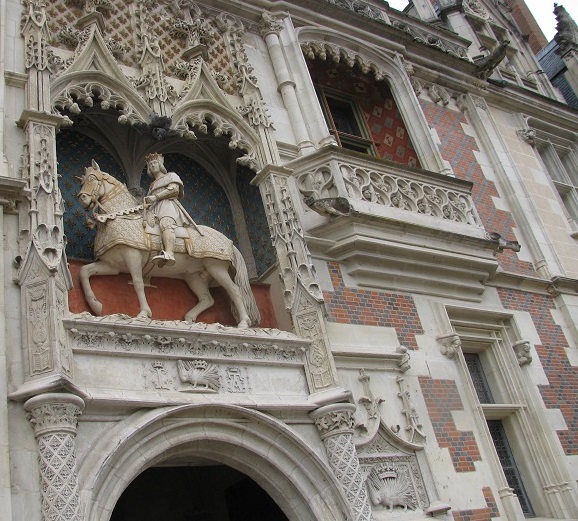
Below him, his symbol: the crowned porcupine. His motto: qui s’y frotte s’y pique, meaning rub against him and you’ll get pricked (literally) or cross swords with him at your peril or if you don’t watch out you’ll get burned.
The initials to either side of the porcupine: L for Louis and A for Anne, you guessed it, of Brittany, his cousin’s widow. Anne was no looker, but having the duchy of Brittany in her dowry made her quite the catch. Louis therefore obtained the annulment of his own childless first marriage to wed her. Anne’s symbol, the symbol of Brittany, was the ermine, a pattern of black stoat (weasel) coats against a white background.
Viewed from the outer square, Louis XII’s brick-and-stone wing, circa 1500, speaks of the end of an era (Gothic). Inside we follow the call of a new era (Renaissance), a pleasure palace with a vast hallway and a succession of royal apartments. The main Louis XII wing now houses the town’s Beaux-Art Museum (more on the museum later). A chapel, truncated by subsequent developments at Blois, also remains from this time.
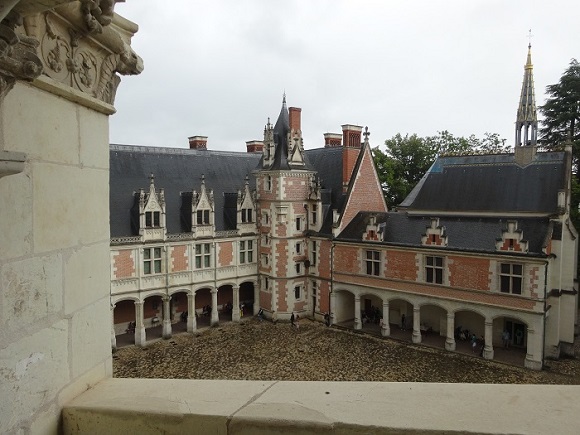
Louis and Anne had two surviving children, daughters, Claude and Renée, however the succession laws of the French kings stated that the crown could only pass to a male heir. That meant the search for good (i.e. useful) marriages for the girls and likely inheritance of the crown by cousin François (Francis). There was therefore no better marriage for Claude (de France), the elder daughter, than to cousin Francois (d’Orléans).
Francois I

In 1515, less than a year into their marriage, Louis XII died and Claude’s husband became King Francois the First (Ier in French). (France has had plenty of Kings Louis and Charles and several Kings Henri but only two Kings Francois, the second being his grandson who reigned for only 17 months before dying from an inner ear problem at age 16.)
Claude, already duchess of Brittany by virtue of her mother Anne (she also inherited her mother’s looks), was therefore queen. Claude died at the age of 24, which gave her enough time to have seven children, including the future king Henri II—or perhaps it’s better said that having seven children by the age of 24 killed her, and getting syphilis from her husband didn’t help.
While Francois has gone down in history as a powerful builder king, Claude is remembered in the name of a sensual green or yellow-green plum, la reine claude, found ripe in markets in August. Francois I remarried after Claude’s death but had no children with his second wife, Eleanore of Austria, though plums continued to grow in the castle gardens. (Those gardens no longer exist; the city has grown into it.)
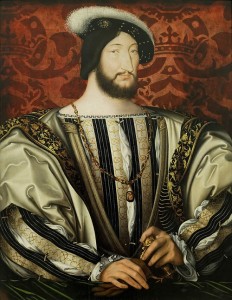
Francois grew up at the Chateau d’Amboise. It was there that he invited Leonardo da Vinci to be his neighbor. But Claude was naturally fond of her home castle at Blois and Francois I was intent on keeping it up-to-date. That meant tearing down portions of his predecessor’s château, already démodé, and creating something stylish and avant-garde.
This year France is commemorating the 500th anniversary of the coronation and reign of Francois (Francis) I. Chateaux great (e.g. Chambord) and small (e.g. Beauregard), however deeply or tangentially touched by the architectural and decorative spirit of the era of Francois I, are unfurling images of the broad-shouldered king with the long straight nose, sporting a thin moustache trickling into a full beard, wearing tights or armor, sitting in equestrian glory or standing in fur-lined grace. Blois itself is hosting a bookish exhibition called “Royal Treasures, the Library of François I,” running July 4-Oct. 18, 2015.
The equestrian statue of Louis XII may get the photo op at the entrance to Blois Castle, but it’s Francois I’s see-and-be-seen staircase that draws the lens once in the courtyard—though how to photograph it properly without looking like it’s been seen in a funhouse mirror is anyone’s guess.
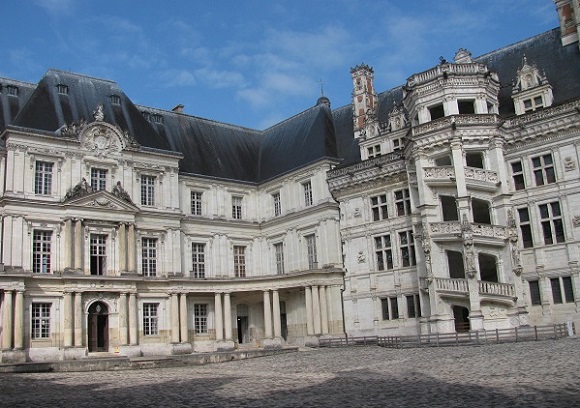
Let me try again.
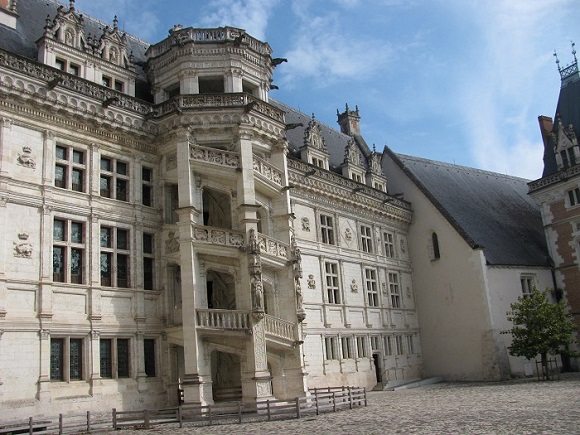
I give up. Photography may have become the lazy man’s travel writing but a skilled photographer still has his place.
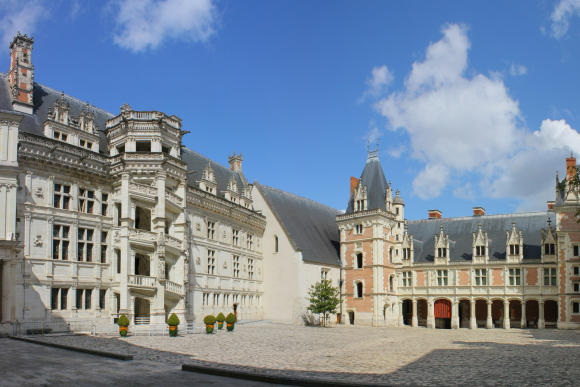
Francois I (1494-1515-1547) would go on to launch enormous royal projects at Chambord, Fontainebleau and the Louvre, but he made his first mark on royal architecture at Blois. Palaces constructed or altered in his name were signed with his royal symbol the fire-breathing salamander and the motto nutrisco et extinguo referring to flames that nourish his people and extinguish his enemies.
The salamander sets the tone for decorative relief by the base of the showy outer staircase that defines the Francois I wing.

This is Blois’ architectural claim to fame. With loggia for nobility to look out onto the courtyard and to be seen from below, the theatrical staircase (1515-1519) and the wing of the castle that it serves set the stage for a new architectural style that would now developing throughout the valley. The Francois I wing gave royal momentum to the French Renaissance, thanks largely to Italian architects and decorators in its early phases.
This is no Eiffel Tower. Go to the top of the staircase and you’ll have little more than a view of tourist tripping over cobblestones down below (be sure to look up, though at the way in which the structure meets the ceiling). Nevertheless, this remains one of the architectural treasures of the Loire Valley. Again, not enough to plan a honeymoon around, but there you have it, 16th-century architectural sophistication—dramatic staircases were becoming all the rage.
If approaching from the train station, a 10-15 minute walk, your first view of the chateau is the back of the Francois I wing. Based on an Italian model, it looks more like an apartment building in Rome than a royal castle along the Loire.
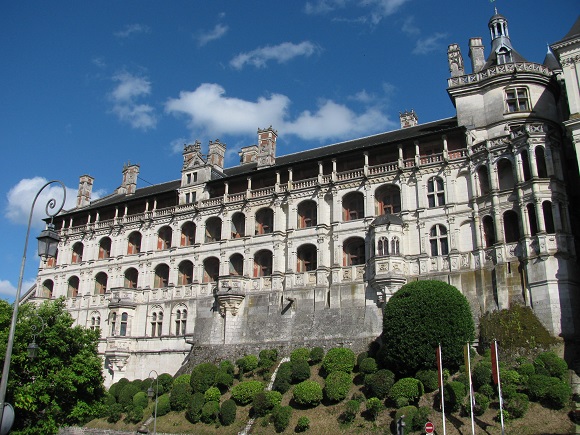
It used to overlook the castle gardens but now faces a city road that wraps around a tremendous Atlas cedar. Beyond the cedar, one can also see from the balcony the orangery where citrus trees from the castle gardens were placed in winter. (The historical building now houses a gastronomic restaurant.)
Francois gets the architectural shout-out for this wing with the famous staircase, but the historical tale told inside speaks more about the era of his grandson Henri III.
Henri III
Francois I’s son Henri II (1519-1547-1559), who eventually died from being poked in the eye during a jousting tournament, preferred to place his architectural monograms elsewhere, including on the Louvre and at Fontainebleau. But Blois continues to speak of the presence of Henri II’s queen Catherine de Medicis and of their third son, Henri III (1551-1574-1589).
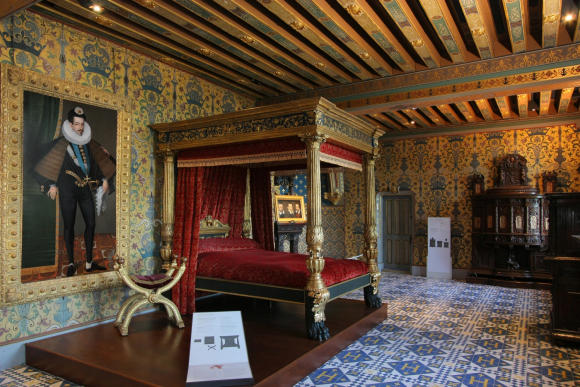
Henri III’s era of the French Court was as perverse and manipulative as our own in terms of power struggles, festivities, fashion, intrigue and assassination. We have our own politics in which a vocal, heavily armed group proclaims that the “true” religion should guide policy; we, too, go in for fear mongering, lies and rumors passed off for evidence that one man or one party will destroy life as we know it; we too hear the siren of the politics of nostalgia, etc. Admittedly, we prefer to assassinate character more than body these days and we pretend that telling an armed public that “someone ought to shoot that guy” is just an expression of disagreement, but we surround our politicians with a sizeable security detail just in case.
In 1576 and again in 1588, Henri III convoked at Blois an assembly of the Three Estates: the clergy, the nobility and the Third Estate, i.e. all others. The assembly took place in the Great Hall of 1214, originally built as a multi-purpose hall for the Counts of Blois. At its best the Estates (or States) General, as it was called, served as an advisory body offering wise counsel to the king. Otherwise it might be a way in which those with lesser or no power could let off steam or a quarrelsome nuisance that the king would ignore. The body met periodically at various venues from the early 14th century until 1614, then not at all until 1789, when discontent was so loud that Louis XVI could no longer postpone the reunion—but more than reunion, revolution was in the air.
The Wars of Religion between Catholics and Protestants marked the tenure of Catherine de Medicis and her three successive royal sons. It came to a head during the reign of Henri III. It was bad enough that factions of warring nobility saw no room to compromise, but the ultra-Catholics felt that disaster would befall the kingdom since Henri III was childless, making the heir to the throne his cousin Henri de Navarre, a Protestant.
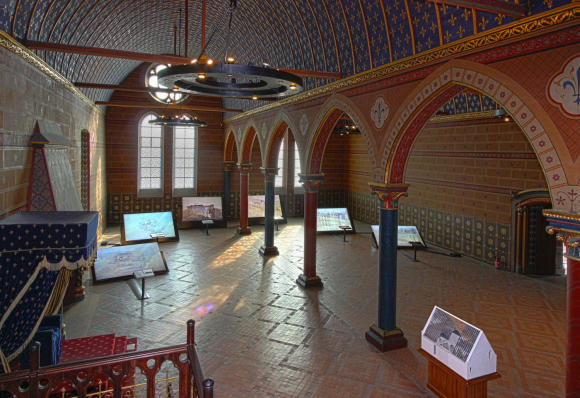
The Great Hall is a magnificent space for its time and for a family photo op on the throne. Portions of the apartments of Catherine de Medicis and of Henri III are also visible. It’s less the heavily restored décor that makes them significant as the events that took place there. With the right guide (human or audio), the events that took place but gets us thinking about how similar the power struggles of the late 16th century are to the politics of our own time.
In order to calm the warrior spirit of the hawkish Catholic nobility and clergy against the Protestants (Huguenots) on the occasion of the Estates General of 1588, Henri III had the Catholic leader Duke Henri de Guise assassinated as the duke was walking through the king’s bedroom to a supposed pow-wow with the king.
“My God he’s tall,” the king is reported to have said upon seeing his slain rival. “He even looks taller dead than alive.”
The Duke de Guise’s brother, the Cardinal de Guise, also a conspirator against the king, was assassinated in Blois Castle the following day.
Twelve days later, Queen Mother Catherine de Medicis, died here of natural causes at the age of 79.
And seven months later, on August 2, 1589, Henri III was in turn assassinated, caught off guard while on the pierced chair (i.e. the can) at the royal Chateau de Saint Cloud (near Paris). His assassin was a monk named Jacques Clément who represented forces of what we would now call the religious far right.
Upon Henri III’s death the king’s chronicler Pierre de l’Estoile wrote: “This king would have been a good prince had he been born in a better century.” It’s doubtful though that such a century has ever existed.
Henri IV
Heir and party to the Wars of Religion, Henri IV was not only a distant cousin rising to the throne but was also a Protestant, two strikes against him that meant he had to conquer his kingdom. He would eventually convert to Catholicism to be in phase with the majority, but without abandoning the reformers.
Photo Henri IV. The central role that the Loire Valley had played in royal politics was coming to an end as the Bourbon kings asserted a firm hand throughout the kingdom and took up more frequent residence in Paris and then Versailles. Henri IV’s main association with the Loire is far downstream at Nantes, where he signed the edict that granted the right to Protestants to practice their religion in peace along with certain politic rights, thus closing the Wars of Religion in France.

He nevertheless showed enough interest enough in Blois to order the construction of a new building in the gardens. As a builder, his heart—before it was pierced by an assassin monk in Paris in 1612—was more focused on urban projects in the capital.
After his assassination his queen Marie de Medicis assumed the regency for underage Louis XIII. But a power struggle ensued when he son reached royal majority in his mid-teens and he exiled her to Blois to keep her from meddling in affairs of state. A painting in the Louvre, La Fuite de Blois by Rubens, shows her escaping from Blois through the construction site that had been launched by Henri IV. That building was never completed and was eventually demolished.
(To recap royal deaths from 1498-1612: Charles VIII died from banging his head on a door lintel at age 27; Louis XII died from intestinal trouble at age 52; Francois I died from septicemia related to fistula around the unmentionables and kidney failure at age 53; Henri II died from a brain infection caused by being poked in the eye at a jousting tournament at age 40; Francois II died from an ear infection at age 16; Charles IX died from pleurisy at age 23; Henri III was assassinated by a monk will sitting on the can at age 47, and Henri IV was assassinated by a monk while riding in his carriage at age 56. Not pretty, but, ah, but the castles they built!)
Gaston, Duc d’Orléans
Louis XIII saw no need to keep Blois Castle in the French crown and so gave it to his younger brother Gaston in 1626. Had the power days of Blois ended? Not if Gaston could help it. Any pretext was good for Gaston (1608-1660) to conspire against or otherwise disobey his brother because as long as Louis XIII and Queen Anne didn’t have a son he remained first in line for the throne.

By the second decade of their childless marriage, Gaston could reasonably dream of occupying the throne should his older brother predecease him. Blois would then become a royal residence again.
So Gaston hired one of the top architects of the time, Francois Mansart, to build a new wing to his castle, thus bringing Blois into the modern era of the 17th century. Gaston may well have rebuilt the entire castle, razing the previous structures like an old villa on beachfront property, but the throne eluded him. In 1738, after nearly 23 years of marriage, Anne of Austria gave birth to a son (presumably fathered by Louis XIII). The existence of a healthy boy distanced Gaston one step further from the crown, and when Louis XIII died five years later, the boy became Louis XIV.
The Gaston wing resembles a stand-alone chateau and is notable for its relatively early Classicism, but viewed from the courtyard it sticks out as ambition gone wrong; the focal point of the courtyard remains the Francois I wing with its external staircase. Architect Francois Mansart would lend his name to the mansard, a high-pitched roof pierced with windows, then coming into fashion.
The grace of the Gaston/Mansart wing comes especially from the symmetry of the central structure with pavilions on either side reaching out to embrace the courtyard. Through his work here and elsewhere, Mansart nevertheless helped usher in an architectural style that would later become associated not with Gaston Ier but with Louis XIV.
Louis XIV’s prime minister Mazarin, tired of Gaston’s conspiring against the crown during the king’s youth, eventually exiled Gaston to Blois. There he lost the ambition (and perhaps the funding) to complete his dream castle.
The decorative elements of the interior were never finished. The interior monumental staircase of the Gaston wing, crowned by a copula, looks like a grand stage between plays. But Blois was now far from center stage, and the Loire Valley itself was soon but a sideshow as, about the time of Gaston’s death in 1660, Louis XIV began drawing plans for the entire theater district move to Versailles.
The Beaux Arts Museum
The main Louis XII wing houses a small collection that lends itself as much to pleasant if disinterested meandering as it does to a more studious examination of representative 16th- and 17th-century paintings, and to a lesser extent 18th- and early 19th-century works, including glossy, theatrical historical works from the early 19th century called “troubadour” paintings.
For students of 19th-century restorations of medieval and Renaissance castles, Blois Castle is a must see. But since none of those students is reading this, we might be tempted to pretend that that the original equestrian statue at the castle entrance wasn’t actually destroyed during the Revolution and that this window with the ermine of Anne of Brittany has been safely in place for 500 years.
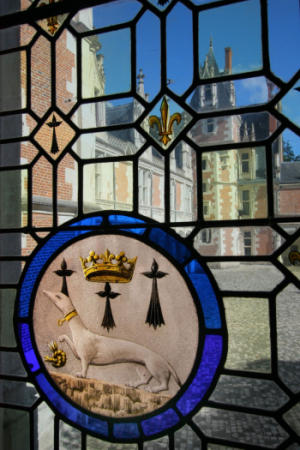
No, let’s not pretend. Let’s be truthful here: The history of French chateaux is rarely that of a single moment in history, and all the more so at Blois. What we see is the result of evolving tastes and ambitions, good fortune and bad, and restoration. In 1788 Louis XVI, five years short of the guillotine, abandoned any royal prerogative to Blois Castle. It then served as barracks for troops and officers with no interest in protecting its historical significance. With the Revolution soon banging at the door there was no interest in protecting its royal symbols either. What was saved was saved for practical rather than historical or emotional reasons.
Then, several decades later, historical mindfulness came calling. In 1840 Blois became one of the first royal complexes in France to be designated a historical monument. Major restoration began several years later, beginning with the rehabilitation of the Francois I wing. The Beaux-Arts Museum opened in 1869.
A room inside this chateau is dedicated to the 19th-century restorers, particularly one Félix Duban, an architect who oversaw the restoration of Blois Castle until his death in 1870. In his terrific travel book “A Little Tour in France,” Henry James, writing in the 1880s, laments the heavy-handed restoration work that he encounters on his tour of the provinces. Nevertheless, it’s thanks to that post-royal history—as barracks, as possession of the city, as object of restoration—that we get to see and to appreciate the lessons in history and architecture that Blois teaches.
To Blois or not to Blois
That remains the question. Is it more rewarding to aim for the monumental unity of Chambord, the loveliness of Chenonceau, the dramatic view of Chaumont, or to get studious with Blois? You can’t go wrong as you plan or wing your way through the castle-rich area of the Loire Valley between Blois and Saumur. Still, a traveler much choose between chateaux while leaving time to enjoy the other pleasures that the region offers—vineyards, gardens, culinary explorations, a zoo, a long stroll by the river.
The architectural developments themselves may seem insignificant 500 years on. Nevertheless, Blois, considered a (perhaps the) key to the Loire Valley, deserves attention.
© 2015 Gary Lee Kraut
Useful information
Château de Blois, Blois Castle, is open daily except Dec. 25 and Jan. 1. Fencing demonstrations are given July 13-Aug. 16, 2015. One reason to spend the night in or near Blois is to attend the wonderful sound-and-light show in the castle courtyard, April 4-Sept. 20, 2015.
Blois Tourist Office, is next to the castle at 23 Place du Château. Tel. 02 54 90 41 41. The office and its website also provide information about chateaux in the surrounding area.
Maison de la Magie, the magic museum and fun house across the square from the castle entrance. Watch for the dragons in the window. Open April 4-Sept. 20 and Oct. 17-Nov. 1, 2015.
Loire à Vélo is the name of the Loire Valley biking system covering a cycle trail of about 500 miles. Its official website is here.
Getting to Blois: From Paris, there are infrequent direct trains to Blois from the Austerlitz Station. They take 1 hour 25 minutes. More frequent indirect trains take 2 hours, arriving in Blois via Orleans (from Paris’s Austerlitz Station) or via Saint Pierre des Corps (from Paris’s Montparnasse Station). A daytrip from Paris is possible. One worthwhile approach to beginning your longer Loire Valley stay in Blois is to spend the first day and perhaps night in the town before renting bikes or a car for wider explorations in the valley. Bus service from Blois goes to the nearby chateaux of Beauregard, Cheverny and Chambord. Inquire at the Blois Tourist Office or see the bus schedule here.
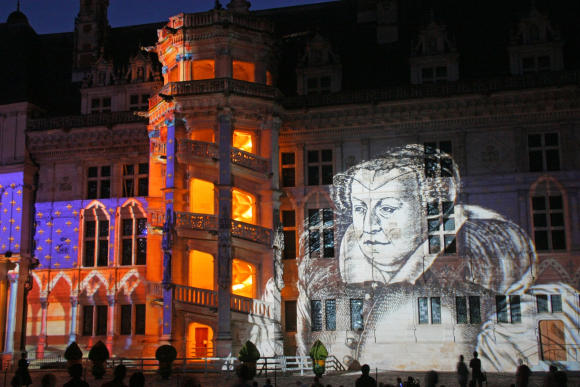
Lodging in Blois and the surroundings area
B&Bs
La Maison de Thomas, 12 rue Beauvoir, 41000 Blois. Tel. 09 81 84 44 59 or 06 60 14 41 41. In the heart of the town, a friendly townhouse for those without wheels or for a night in Blois before or after a biking trip.
16 Place Saint Louis, 16 place Saint Louis, 41000 Blois. Tel. 02 54 74 13 61. At Philippe Escoffre’s B&B a 5-minute hike uphill from center, three cozy rooms look out to the cathedral and over the river. Yes, the name is the address.
Le Plessis, 195 rue Albert 1er, 41000 Blois. Tel. 02 54 43 80 08. On the downstream edge of the town with a chemical-free, salt-water swimming pool.
Le Clos Pasquier, 10-12, Impasse de l’Orée du Bois, 41000 Blois. Tel. 02 54 58 84 08. Claire and Laurent Nicot’s B&B in a 15th-century manor house is another 1.5 miles further downstream.
Hotels
Côté Loire – Auberge Ligérienne 2 place de la Grève, 41000 Blois. Tel. 02 54 78 07 86. A 2-star hotel and restaurant in Blois by the river.
L’Auberge du Centre, 34 Grande Rue, 41120 Chitenay. Tel. 02 54 70 42 11. Nine miles south of Blois. I found this 3-star village hotel with a pleasant restaurant. A choice stop during a biking trip in this portion of the valley.
La Maison d’à Côté, 26 rue de Chambord, 41350 Montlivault. Tel. 02 54 20 62 30. An 8-room inn with restaurant (1 star Michelin in 2015) 6 miles upstream from Blois toward Chambord
Le Château du Breuil, 23 route de Fougères, 41700 Cheverny. Tel. 02 54 44 20 20. Ten miles southeast of Blois, in the countryside two miles from the Chateau de Cheverny, Véronique and Bernard Gattolliat’s 39-room 4-star hotel with restaurant an swimming pool.
Domaine des Hauts de Loire, 79 rue Gilbert Navard, 41150 Onzain. Tel. 02 54 20 72 57.Ten miles downstream from Blois, across the river from Chaumont, a 4-star chateau hotel and restaurant. The 170-acre property also has a tennis court, outdoor pool, a pond where one can fish and bikes.
Restaurants in Blois
For a daytripper, one of the cafés below the chateau de Blois should suffice, or simply a sandwich and pastries from one of the bakeries in that area.
For those spending the evening: I’ve fond memories of a relaxed, gastronomic dinner at Christophe Cosme’s Le Rendez-vous des Pêcheurs, 27 rue du Foix. Tel. 02 54 74 67 48. Closed Sun. and Mon. There’s also the Auberge Ligérienne, a part of the hotel Côté Loire noted above. For a more formal meal in an airy historical setting there’s L’Orangerie du Château, 1 avenue Jean-Laigret. Tel. 02 54 78 05 36. It occupies the former citrus green house or orangery of the chateau. Also closed Sun. and Mon. For a more contemporary decor, more contemporary gastronomy, Assa, one mile downstream from center on the edge of the Loire, has 1 Michelin star (2015). 189 quai Ulysse Besnard. Tel. 02 54 78 09 01. Closed Sun. dinner, Mon. Tues.
– GLK


